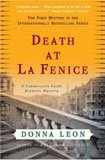For me, one of life’s simple pleasures comes when I finish a book, and then get to decide what to read next. Such a moment came tonight. I finished Donna Leon’s “Death at La Fenice,” and now I can stand at my bookshelf–the top shelf, filled with books I haven’t read yet, but which I fully intend to read, eventually–and make a choice. I always end up reading the backs of the books, even though I’ve read them before, searching for some piece of description that will snag my interest sufficiently so that I declare to myself, “This is the book.”
I did that some already tonight. Haven’t made a selection yet.
So, let me review what I’ve been reading. For the past several novels, I’ve chosen detective-genre books set in unusual (for me) surroundings. Philip Kerr’s “March Violets” was a detective novel set in Berlin just before World War II began. Before that, I read Dan Fesperman’s “Small Boat of Great Sorrows,” set amidst the not-too-distant atrocities of present-day Bosnia. Both of those books were outstanding. Curt Colbert’s “Sayanorraville” took me into the post-WW2 Japanese and Chinese immigrant communities in Seattle. And now, the beautifully written “Death at La Fenice” featured a plodding detective in Venice, Italy.
 Commissioner Guido Brunetti never displayed a hint of violence, and guns weren’t mentioned in the whole book. I loved this piece of description early on about Brunetti: “His clothing marked him as Italian. The cadence of his speech announced that he was Venetian. His eyes were all policeman.” Superb!
Commissioner Guido Brunetti never displayed a hint of violence, and guns weren’t mentioned in the whole book. I loved this piece of description early on about Brunetti: “His clothing marked him as Italian. The cadence of his speech announced that he was Venetian. His eyes were all policeman.” Superb!
In 2000, Pam and I spent a day in Venice. That’s where I first tasted the unparralled Italian ice cream called “gelato” (not a bit like what fraudsters might call “gelato” in the States). It was a little ice cream shop facing the main canal, just at the end of the covered bridge. Venice, thanks to global warming, is a doomed city. It’s already sinking somewhat, and massively heroic measures are being taken to hold back the sea. But with water levels bound to rise a foot or more in the next few decades, there’s not much that can be done.
Because of that single day’s experience in Venice, the book felt a bit familiar to me. Interestingly, while all the other books were written in first-person, which is the viewpoint of choice for detective fiction, this one was written in third person, and needlessly so, I think. Brunetti appeared in every scene, and you viewed every scene through his eyes, which makes it ideal for first-person (much more intimate) writing. When you, for instance, describe a room in a piece of fiction, you should describe it not from multiple different angles, but through the eyes of a single person located somewhere in that room (so you can say “To the left was…” and “Against the far wall stood…). In “Death at La Fenice,” everything was described through Brunetti’s eyes, but not by him, which I felt sacrifices something. But it worked okay. Brunetti is neither hard-bitten nor sarcastic, as are most protagonists in this genre. It was a well-done book with a satisfying ending (which I didn’t anticipate, despite the clues dropped along the way), but I’m not sure I’ll read another one. I prefer the first-person, quick-punching, pistol-waving investigators of the Chandler/Parker variety.
After reading these books set in exotic settings or different time periods, I’m not as interested in trade paperbacks by such mass-market novel juggernauts as John Sanford and James Patterson (though Robert Parker will never lose my favor). Chandler still does it best, but I’m fully intrigued by Philip Kerr’s “Berlin noir” books. He writes wonderfully, and the backdrop of Nazi Germany makes it engrossing. Alas, I don’t have another Kerr book on my shelf, so for now, I’ll force contentment from some other book.





